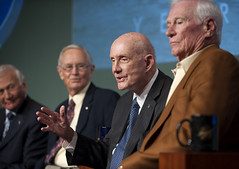Space Flight
"Tar Heels in Space"
by Jim Sumner
Reprinted with permission from the Tar Heel Junior Historian. Fall 2003.
Tar Heel Junior Historian Association, NC Museum of History
 Barely a half century after the Wright brothers’ first flight, people were flying in outer space. Numerous North Carolinians have played important roles in this ongoing effort to explore the “final frontier.”
Barely a half century after the Wright brothers’ first flight, people were flying in outer space. Numerous North Carolinians have played important roles in this ongoing effort to explore the “final frontier.”
The United States became serious about space flight in the years after World War II. The country’s earliest efforts took place under the control of the Department of Defense and the National Advisory Committee for Aeronautics. Space was regarded as part of the cold war between the United States and the Soviet Union. Most Americans in the 1950s were convinced of their country’s technological superiority. That belief was shaken badly on October 4, 1957, when the Soviet Union launched Sputnik, the world’s first satellite. The following year, the United States responded by establishing the National Aeronautics and Space Administration to oversee its space efforts. This organization is known by its initials, NASA.
On February 14, 1961, Granville County native James Edwin Webb became the second administrator of NASA. Three months later, President John F. Kennedy announced, “I believe that this nation should commit itself to achieving the goal, before this decade is out, of landing a man on the Moon and returning him safely to Earth.” The so-called space race to the moon became a national priority, and James Webb’s job became very important.
Webb was a native of Tally Ho, North Carolina. His father was superintendent of the Granville County public schools. James Webb graduated from the University of North Carolina at Chapel Hill in 1928. At various times, he was a marine, a lawyer, a business executive, and a government official in Washington, D.C. Webb knew how to run an organization, create support for the space program, and obtain money from Congress. Under his leadership, NASA first sent Americans into space in the Mercury and Gemini programs in the 1960s. NASA also began the Apollo program, which would win the space race and send astronauts to the moon in 1969. Webb also instituted a vigorous program of unmanned space-science launches.
 On January 27, 1967, astronauts Virgil “Gus” Grissom, Edward White, and Roger Chaffee were killed in a fire on the ground while conducting experiments in an Apollo capsule. Webb said, “We’ve always known that something like this was going to happen sooner or later. . . . Who would have thought that the first tragedy would be on the ground?” Webb worked with NASA and Congress to find out what went wrong. He absorbed so much of the criticism himself and left NASA in 1968. Historians give Webb high marks for his leadership. In 2002 NASA announced that it would name a future space-based observatory the James Webb Space Telescope.
On January 27, 1967, astronauts Virgil “Gus” Grissom, Edward White, and Roger Chaffee were killed in a fire on the ground while conducting experiments in an Apollo capsule. Webb said, “We’ve always known that something like this was going to happen sooner or later. . . . Who would have thought that the first tragedy would be on the ground?” Webb worked with NASA and Congress to find out what went wrong. He absorbed so much of the criticism himself and left NASA in 1968. Historians give Webb high marks for his leadership. In 2002 NASA announced that it would name a future space-based observatory the James Webb Space Telescope.
James Webb never came close to going into space. But several North Carolinians have made that trip.
Charles Duke was born in Charlotte in 1935 and grew up in Lancaster, South Carolina. He commanded the lunar module for Apollo 16. Duke walked on the moon in April 1972. He is one of only twelve people who have worked on the lunar surface.
A number of more recent astronauts grew up in North Carolina and consider this their home state. These men all flew in one of the space shuttles, the reusable space vehicles that were first launched in 1981.
Curtis Brown grew up in Elizabethtown, Bladen County, before training as an air force pilot. He became an astronaut in 1988 and flew on six space shuttle missions between 1992 and 1999. Brown has spent fifty-eight days in space. In 1999 he served as a crew member on a flight that upgraded the Hubble Space Telescope.
William Edgar Thornton, from Faison, Duplin County, was the first North Carolina astronaut selected by NASA. While at NASA, Dr. Thornton made a number of discoveries, often with equipment that he designed. He flew his own medical lab on Challenger in 1983, when that shuttle made its first night launch. He went into space again with the first animal study in 1985 and retired from NASA in 1994.
William “Bill” McArthur grew up in Robeson County. He became a United States Army aviator, and he went into space in 1993, 1995, and 2000. McArthur was in space for thirty-five days altogether and spent thirteen hours outside the shuttle, performing experiments. His 1995 mission involved docking with the Russian space station Mir.
Charles Brady was born in Pinehurst, Moore County, and grew up in nearby Robbins. He graduated from the University of North Carolina at Chapel Hill and Duke University Medical School. Dr. Brady became an astronaut in 1992. He flew on space shuttle mission STS-78 in 1996, logging more than four hundred hours in space.
On January 28, 1986, the space shuttle Challenger exploded on liftoff, killing all seven crew members. The pilot, Michael Smith, was a native of Beaufort, Carteret County, and was on his first space flight. He carried a North Carolina flag with him. Also on the Challenger that day was Ronald McNair, a South Carolina native who had graduated from North Carolina A&T State University. Dr. McNair had been in space in 1984 and was an engineer. His job was to conduct scientific experiments. There were no North Carolinians on the shuttle Columbia when it burned up upon reentry on February 1, 2003.
Not all of North Carolina’s contributions to space exploration have been made by Tar Heels who went into space. Most United States astronauts in the 1960s trained at Morehead Planetarium on the campus of the University of North Carolina at Chapel Hill. There they learned celestial navigation, or how to navigate in space by looking at stars. More recently, North Carolina State University’s Mars Mission Research Center has conducted research on proposed future trips to Mars. The Mars Mission Research Center is now part of the North Carolina Space Grant Consortium. The consortium was established in 1991 to coordinate space research in the state. North Carolina State University and North Carolina A&T State University became the first two members. They have been joined by Duke University, North Carolina Central University, the University of North Carolina at Charlotte, Winston-Salem State University, the University of North Carolina at Chapel Hill, and the University of North Carolina at Pembroke.
North Carolina astronauts, administrators, and scientists are just some of the contributions this state has made to the space program. These contributions will continue, as the human race continues to expand its presence in outer space.
At the time of this article’s publication, Jim Sumner was the curator of sports and a research historian at the North Carolina Museum of History. He also served on the Pioneers of Aviation Exhibit Team.
Additional Resources:
HubbleSite: The James Web Space Telescope: http://webbtelescope.org/webb_telescope/
Lyndon Baines Johnson Library Oral History Collection, University of Texas, James E. Webb Oral History Interview: http://www.lbjlib.utexas.edu/johnson/archives.hom/oralhistory.hom/WEBB-J....
Morehead Plantarium and Science Center, Astronaut Training: http://www.moreheadplanetarium.org/index.cfm?fuseaction=page&filename=hi....
North Carolina Digital Publishing Office. “North Carolina and the Space Race.” MosaicNC.org. July 2020. https://mosaicnc.org/space-race (accessed September 13, 2023).
Apollo Astronauts at UNC: http://www.lib.unc.edu/blogs/ncm/index.php/2009/07/20/apollo-astronauts-....
NASA, Astronaut Biographies: http://www.jsc.nasa.gov/Bios/.
Image Credits:
NASA Web Telescope."Space Telescope Secondary Mirror." July 19, 2011. Located https://www.flickr.com/photos/nasawebbtelescope/5954656289/. Accessed March 2, 2012.
Nasa HQ Photo. " Apollo 40th Anniversary Conference." July 20, 2009. Located at https://www.flickr.com/photos/nasahqphoto/3740456966/. Accessed March 2, 2012.
Shipul, Ed. "Bill McAurthur, Astronaut." November 28, 2006. Located at https://www.flickr.com/photos/eschipul/309125364/. Accessed March 2, 2012
1 January 2003 | Sumner, Jim L.